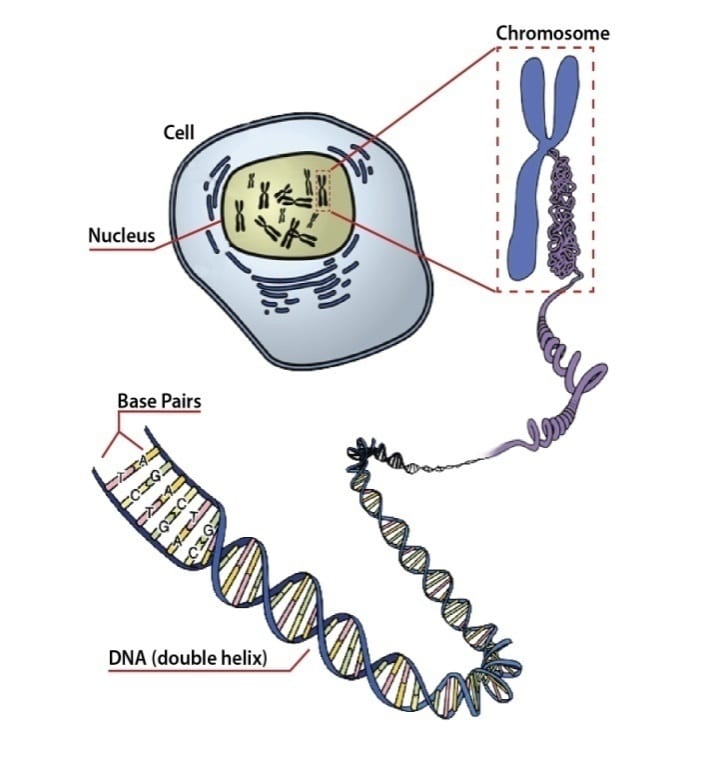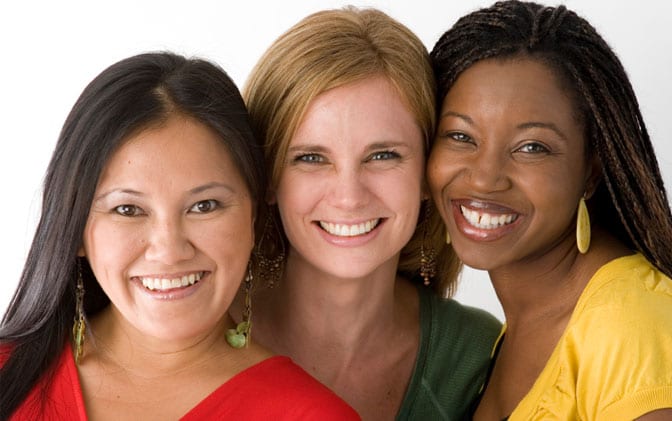Introduction
 Below is a very brief explanation of DNA and the role it plays in life. It is not necessary for the reader to understand this to be able to appreciate the point being made, so simply skip the introduction and go directly to the main text; Mitochondrial DNA if you prefer.
Below is a very brief explanation of DNA and the role it plays in life. It is not necessary for the reader to understand this to be able to appreciate the point being made, so simply skip the introduction and go directly to the main text; Mitochondrial DNA if you prefer.
All life, animal and plant have genes which give the special features of that life-form and are passed down to the next generation. Genes are sections of the enormously large deoxyribonucleic acid, DNA for short, molecule. DNA comprises four different molecules called nucleotides which are joined together into long strings. The strings come in pairs and are twisted into what became famously known as the “Double Helix.” Each nucleotide is comprised of an organic base, a sugar called deoxyribose and a phosphate backbone. In all life, there are four different types of organic bases and it is these that give rise to four different types of nucleotides known as A, T, G and C. The information encoded into DNA that is used to construct the life-form is by way of the order of these four nucleotides just as computer information is based on the binomial system; O’s or 1’s.
There are over three billion nucleotides in the human DNA and these are present in bundles called chromosomes and each creature has a different number of chromosomes. Only species which have the same number of chromosomes can breed; humans have 23 pairs giving 46, apes 48, barley have 14, grape 38, dog 78 and horse 64 and so on.
Life is incomprehensively complex.
Mitochondrial DNA
The DNA is located in the nucleus of each cell and in higher animals some is present in a part of the cell known as the mitochondria. DNA in the mitochondrial part of our cells is passed on to us exclusively from our mother and it is identical with hers except for mutational changes. Only recently, researchers have been able analyse DNA and determinate what changes have been made through mutations.[1] On average each generation produces about 100 mutations.
 During the 1980s, researchers studied the DNA from people from all over the globe and came to the surprising conclusion (for evolutionists, but not Bible-believing Christians) [2]) that all women came from a single woman estimated to have lived some 200,000 years ago—in fact, evolutionists called her ‘Mitochondrial Eve’.[3] This story was carried in newspapers around the world. What was not nearly so well publicised was the fact that the scientists who carried out the work had miscalculated the rate of mutations for mitochondrial DNA. The rate was later shown to be much faster than previously thought and the revised date for ‘Mitochondrial Eve’ is now 6,000 to 6,500 years ago[4] which fits very nicely with the calculated time of creation of about 6,000 years ago which is based on generations from Adam and the length of the lives given in the Bible.
During the 1980s, researchers studied the DNA from people from all over the globe and came to the surprising conclusion (for evolutionists, but not Bible-believing Christians) [2]) that all women came from a single woman estimated to have lived some 200,000 years ago—in fact, evolutionists called her ‘Mitochondrial Eve’.[3] This story was carried in newspapers around the world. What was not nearly so well publicised was the fact that the scientists who carried out the work had miscalculated the rate of mutations for mitochondrial DNA. The rate was later shown to be much faster than previously thought and the revised date for ‘Mitochondrial Eve’ is now 6,000 to 6,500 years ago[4] which fits very nicely with the calculated time of creation of about 6,000 years ago which is based on generations from Adam and the length of the lives given in the Bible.
Using mitochondrial DNA studies, Dr Robert W Carter makes an interesting case that there are three basic mitochondrial lineages across the world and evolutionists call them ‘M’, ‘N’ and ‘R’. These can be related to the three wives of Noah’s sons who were aboard the ark from whom all woman came after the flood.[5]
Interestingly, there is a parallel case with males. All males inherit their Y chromosome from their fathers and studies have shown that all men come from a single man, although to be consistent with evolution assumptions, they propose a date of several hundreds of thousands of years.[6] However, the data can be shown to be consistent with him living at about the same time as Mitochondrial Eve using the revised shorter date;[7] he is known as Y-Chromosome Adam.
Conclusion
It is good to see that science is slowly catching up with the Bible; all humanity came from one completely human man and one completely human woman, just as the Bible says and not from some primate whose, by the way, DNA has been found recently, to be significantly different.[8]
[1] As DNA is copied into a new cell, sometimes a copying mistake is made. There is built into the cell machinery to correct these copying mistakes but occasionally some mistakes get through; these are called mutations.
[2] Genesis 3:20.
[3] Jonathan D Sarfati, The Genesis Account, Creation Book Publishers, 2015, page 385, citing the following reference; W M Brown, Polymorphism in mitochondrial DNA as revealed by restriction endonuclease analysis, PNAS, 77(6), 1980, pages 3605-9;
[4] L. Loewe and S. Scherer, Mitochondrial Eve: the plot thickens, Trends in Ecology and Evolution 12, 1997, pages 422–423; A. Gibbons, Calibrating the mitochondrial clock, Science, 1998, 279(5347), pages 28–29; T J Parsons, A high observed substitution rate in the human mitochondrial DNA control region, Nature Genetics, 15, 1997, pages 363-368.
[5] http://creation.com/noah-and-genetics; Carter, R W, The Neutral Model of evolution and recent African origins, J Creation, 2009, 23(1), pages 70-77.
[6] Jonathan D Sarfati, The Genesis Account, Creation Book Publishers, 2015, page 386, citing the following reference; R L Dorit, et al, Absence of polymorphism at the ZFY locus on the human Y- chromosome, Science, 268(5214)26 May 1995, pages 1183-85; perspectives in the same issue by S Paabo, The Y-chromosome and the origin of all of us (men), pages 1141-2.
[7] D Batten, Y-Chromosome Adam? J. Creation, 9(2), 6 June, 1995, pages139-140.
[8]Jonathan D Sarfati, The Genesis Account, Creation Book Publishers, 2015, page 385.

